2010-2012 NC Hops Project Methods
go.ncsu.edu/readext?468885
en Español / em Português
El inglés es el idioma de control de esta página. En la medida en que haya algún conflicto entre la traducción al inglés y la traducción, el inglés prevalece.
Al hacer clic en el enlace de traducción se activa un servicio de traducción gratuito para convertir la página al español. Al igual que con cualquier traducción por Internet, la conversión no es sensible al contexto y puede que no traduzca el texto en su significado original. NC State Extension no garantiza la exactitud del texto traducido. Por favor, tenga en cuenta que algunas aplicaciones y/o servicios pueden no funcionar como se espera cuando se traducen.
Português
Inglês é o idioma de controle desta página. Na medida que haja algum conflito entre o texto original em Inglês e a tradução, o Inglês prevalece.
Ao clicar no link de tradução, um serviço gratuito de tradução será ativado para converter a página para o Português. Como em qualquer tradução pela internet, a conversão não é sensivel ao contexto e pode não ocorrer a tradução para o significado orginal. O serviço de Extensão da Carolina do Norte (NC State Extension) não garante a exatidão do texto traduzido. Por favor, observe que algumas funções ou serviços podem não funcionar como esperado após a tradução.
English
English is the controlling language of this page. To the extent there is any conflict between the English text and the translation, English controls.
Clicking on the translation link activates a free translation service to convert the page to Spanish. As with any Internet translation, the conversion is not context-sensitive and may not translate the text to its original meaning. NC State Extension does not guarantee the accuracy of the translated text. Please note that some applications and/or services may not function as expected when translated.
Collapse ▲Written by Rob Austin. This project was conducted by Rob Austin and Scott King in Soil Science (now Crop and Soil Sciences) and Jeanine Davis in Horticultural Science. It was funded by a GoldenLeaf Foundation grant. Reviewed 6/7/2022.
Site Description
The experimental hops yard was located south of Raleigh at the Lake Wheeler Road Field Laboratory. The site was situated off Lake Wheeler Road (on Mid Pines) about 5 minutes from NC State’s main campus. Located in the Piedmont of North Carolina, the quarter acre site receives full sun and slopes gently Northwest (~4%). The soils at the site are deep, well drained, and rocky, with a sandy clay loam surface texture. The dominant soil series is Appling.
Site Design
The experimental hop yard contained 200 total plants on 1/4 of an acre. Twenty plants each of 10 different varieties were selected based on their range of alpha acids (bitterness), yield potential, disease and pest resistance, total U.S. production, and demand by local craft breweries (Figure 1). Each set of 20 plants was split into rows of 5 and randomly planted within 4 distinct blocks. This layout was designed to minimize the potential effects of agronomic variability and strengthen the identification of properties or characteristics that are unique to each variety (Plot Layout).
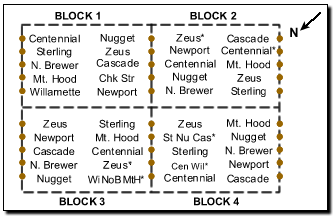
Figure 1: Experimental design at the Lake Wheeler hops yard. Ten varieties are split into 4 blocks and randomly planted in groups of 5.
Site Preparation – Initial Soil Testing
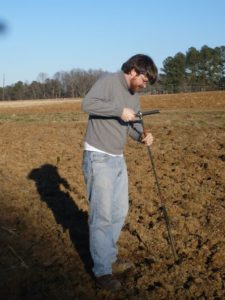 In order to understand and manage the within field variability of the soils at the site, soil samples were collected using a ‘precision farming’ approach. Instead of collecting a few composite samples that average the results over the entire field, samples were collected from every point in a regular spaced grid. The samples were still composites; however, the samples were collected within a 3-meter diameter of the sample location. The locations were GPS’ed and the results were visualized and analyzed using a Geographic Information System (GIS)). For more information about performing site-specific soil sampling see the SoilFacts publication, “Soil Sampling for Precision Farming Systems”).
In order to understand and manage the within field variability of the soils at the site, soil samples were collected using a ‘precision farming’ approach. Instead of collecting a few composite samples that average the results over the entire field, samples were collected from every point in a regular spaced grid. The samples were still composites; however, the samples were collected within a 3-meter diameter of the sample location. The locations were GPS’ed and the results were visualized and analyzed using a Geographic Information System (GIS)). For more information about performing site-specific soil sampling see the SoilFacts publication, “Soil Sampling for Precision Farming Systems”).
In total, 12 soil samples were collected at approximately 15 by 20 feet apart and submitted to NCDA&CS for soil testing (remember, in North Carolina soils tests are free for both growers and homeowners – find out more). A soil test provides information about the elements needed by plants (e.g. phosphorus, potassium, calcium, magnesium, sodium, sulfur, manganese, copper, and zinc) that are available in the sample. These amounts help determine the amount of fertilizer required by a crop. In addition, soil pH, humic matter, and exchangeable acidity are provided and helped identify liming requirements. (picture gallery)
Bedding
During the week of March 8th, 2010 the field was disked and bedded. Overall, the field was disked three times before it was ready to bed. The field was limed and fertilized between disking. The resulting beds are ~10 inches tall and will help provide good drainage. (picture gallery)
Planting
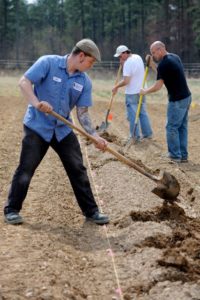 Rhizomes were planted at the experimental site on March 25th and 26th, 2010. The rhizomes were planted horizontally 1″-2″ below the soil surface with the buds pointing up. Each of the 10 rows includes 20 plants broken into sets of 5. Within the sets of 5, the hops are spaced 3.5′ apart. Between varieties, the hops were spaced 5′ apart. At each location, the planting area (or ‘hill’) was amended with 2-3 gallons of quality compost and mixed with the native soil. Immediately after planting the rhizomes were watered. Light watering was continued every 2 to 5 days depending on weather conditions. (picture gallery)
Rhizomes were planted at the experimental site on March 25th and 26th, 2010. The rhizomes were planted horizontally 1″-2″ below the soil surface with the buds pointing up. Each of the 10 rows includes 20 plants broken into sets of 5. Within the sets of 5, the hops are spaced 3.5′ apart. Between varieties, the hops were spaced 5′ apart. At each location, the planting area (or ‘hill’) was amended with 2-3 gallons of quality compost and mixed with the native soil. Immediately after planting the rhizomes were watered. Light watering was continued every 2 to 5 days depending on weather conditions. (picture gallery)
Trellis Construction
A conventional hops trellis is anywhere from 16-20+ feet tall and consists of wood posts interconnected with wire and cables. There are several different trellis configurations used and each provides various trade-offs in cost (labor and fixed), management, production, and cultural practices. There is a presentation from a 2008 Colorado State Workshop that outlines many of various designs and their associated costs here [link].
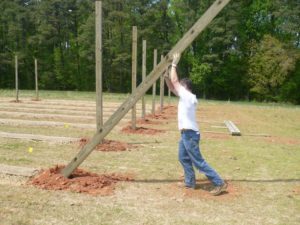 The trellis at the experimental site was constructed of thirty 4×6×16’ posts positioned 4ft in the ground. The resulting 12’ tall trellis is a bit shorter than the traditional trellis common in the Pacific Northwest, but because of the challenges small-scale growers will face with stringing, harvesting, and spraying on a 20+ foot system, we decided that 12 feet was an acceptable compromise between height, cost, and ease of management.
The trellis at the experimental site was constructed of thirty 4×6×16’ posts positioned 4ft in the ground. The resulting 12’ tall trellis is a bit shorter than the traditional trellis common in the Pacific Northwest, but because of the challenges small-scale growers will face with stringing, harvesting, and spraying on a 20+ foot system, we decided that 12 feet was an acceptable compromise between height, cost, and ease of management.
The 30 post are split into 10 rows of 3. Each row is spaced 10′ apart and consisted of 3 posts spread 45 feet apart. The end posts were anchored on each side with 36″ ground anchors, 12 gauge high-tensile fence wire, and pulled tight with spring loaded fence tighteners. The top wire was connected to the end posts using 8″ eyebolts. The wire was looped and crimped around each eye bolt and protected from abrasion with plastic insulated tubing. Each post was drilled with two holes sized for the eyebolts. The holes were drilled at both 6 and 12 feet above ground providing the ability to raise and lower the top wire during stringing and harvest. (picture gallery)
Tissue Testing
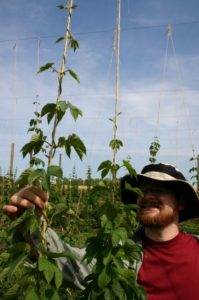 In the mountains, a small community of growers had already established hop yards. We worked with four of these growers to monitor, test, and analyze the existing soil conditions and plant health throughout the growing season. Soil and plant tissue samples were collected using the same ‘site-specific’ approach outlined in the ‘Site Preparation – Initial Soil Testing’ section. This data was used to develop maps that depict the within-field variability of essential nutrients and key soil characteristics.
In the mountains, a small community of growers had already established hop yards. We worked with four of these growers to monitor, test, and analyze the existing soil conditions and plant health throughout the growing season. Soil and plant tissue samples were collected using the same ‘site-specific’ approach outlined in the ‘Site Preparation – Initial Soil Testing’ section. This data was used to develop maps that depict the within-field variability of essential nutrients and key soil characteristics.
Plant tissue samples were collected multiple times throughout the growing season. These samples were used to monitor plant nutrient concentrations and to analyze plant health. The tissue samples were collected June 2nd, during the vegetative stage and rapid production of dry-matter, then again July 15th, during reproduction stage and full flower. The tissue samples will help quantify plant nutrient levels during important growth stages and help identify ranges below which crop yield and plant health are affected.
Cone Quality and Yield
In the mountains, hop cones from each variety were tested for their bittering potential (alpha and beta acids) using the approved spectrophotometric (UV-VIS) procedure from the American Society of Brewing Chemists [procedure details]. At the Lake Wheeler experimental site, hops cones from each plant were collected, weighed, recorded, and tested. To validate results, all tests were run in conjunction with the International Calibration Extract 2 (ICE-2) standard.


